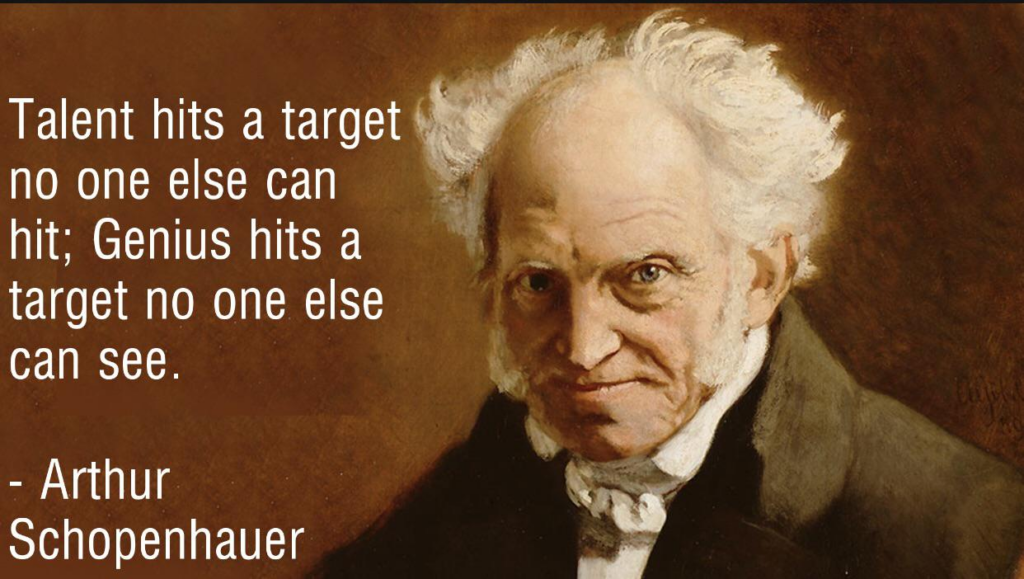
Who was Arthur Schopenhauer
Man can do what he wills but he cannot will what he wills.”
― Arthur Schopenhauer, Essays and Aphorisms
Arthur Schopenhauer’s philosophy has far-reaching implications for the field of psychology and psychotherapy. His ideas about the human condition, the nature of suffering, and the means of transcendence can provide valuable insights for therapists working with clients struggling with existential crises, trauma, and other psychological challenges.
One of the key areas where Schopenhauer’s philosophy can be applied is in existential therapy. Existential therapy is a form of psychotherapy that focuses on helping individuals confront the fundamental challenges of human existence, such as the search for meaning, the inevitability of death, the burden of freedom, and the experience of isolation. Schopenhauer’s view of life as inherently characterized by suffering aligns well with the existential perspective, which acknowledges the inherent difficulties and struggles of the human condition.
Therapists working from an existential framework can draw upon Schopenhauer’s ideas to help clients grapple with the reality of suffering and develop a more authentic and meaningful way of living. By exploring Schopenhauer’s concept of the Will as the driving force behind human behavior and the source of much of our pain, therapists can guide clients to a deeper understanding of their own motivations, desires, and fears. This can be particularly useful for clients who feel stuck in patterns of self-destructive behavior or who struggle with a sense of purposelessness or emptiness.
Moreover, Schopenhauer’s emphasis on the role of aesthetic experiences in transcending suffering can be incorporated into existential therapy. He believed that engaging with art, music, and literature could provide individuals with a temporary escape from the demands of the Will and the pain of existence. Therapists can encourage clients to explore creative outlets and find meaning in aesthetic experiences as a way of coping with the challenges of life. This can involve helping clients identify activities or art forms that resonate with them on a deep level and that provide a sense of joy, beauty, or transcendence.
Another area where Schopenhauer’s ideas can be applied is in the treatment of trauma. Trauma can be understood as an experience of overwhelming, irrational forces that shatter an individual’s sense of safety and meaning. Schopenhauer’s concept of the Will as a blind, insatiable force that drives human behavior can be seen as a metaphor for the overwhelming power of traumatic experiences. Trauma survivors often feel as though they are at the mercy of forces beyond their control, much like how Schopenhauer viewed human beings as driven by the irrational Will.
In working with trauma survivors, therapists can draw upon Schopenhauer’s ideas to help clients make sense of their experiences and develop a more resilient and empowered sense of self. By acknowledging the reality of suffering and the inherent challenges of the human condition, therapists can help clients develop a more accepting and compassionate attitude towards their own pain. This can involve teaching clients mindfulness and self-compassion practices, as well as helping them identify sources of meaning and purpose in their lives.
Moreover, Schopenhauer’s emphasis on the importance of facing reality and avoiding illusions can be useful in trauma treatment. Trauma survivors often struggle with distorted beliefs and perceptions about themselves, others, and the world around them. By gently challenging these distortions and helping clients develop a more realistic and grounded perspective, therapists can support the process of healing and recovery.
Beyond existential therapy and trauma treatment, Schopenhauer’s ideas can be applied more broadly in the field of psychology. His insights into the nature of human motivation, the role of the unconscious in shaping behavior, and the importance of self-awareness and self-reflection can inform a wide range of therapeutic approaches. Therapists can draw upon Schopenhauer’s philosophy to help clients develop a deeper understanding of themselves and their place in the world, as well as to cultivate a more accepting and compassionate attitude towards the challenges of life.
Of course, it is important to recognize that Schopenhauer’s philosophy is not without its limitations and potential drawbacks. His pessimistic worldview and emphasis on the inevitability of suffering may not resonate with all clients or therapeutic approaches. Therapists must be careful to balance Schopenhauer’s insights with a more hopeful and empowering perspective, one that recognizes the potential for growth, healing, and positive change.
Additionally, Schopenhauer’s ideas about the role of aesthetic experiences in transcending suffering should be approached with some caution. While engaging with art and creativity can certainly be a powerful source of meaning and coping for many individuals, it is not a panacea for all of life’s challenges. Therapists must be mindful of the unique needs and circumstances of each client and avoid presenting aesthetic experiences as a one-size-fits-all solution.
Despite these limitations, Schopenhauer’s philosophy remains a rich and valuable resource for therapists and mental health professionals. By engaging with his ideas and applying them thoughtfully and strategically, therapists can deepen their understanding of the human condition and develop more effective approaches to supporting clients in their journey towards greater self-awareness, resilience, and well-being.
Some specific ways in which therapists can apply Schopenhauer’s ideas in their work with clients include:
- Encouraging clients to confront the reality of suffering and develop a more accepting and compassionate attitude towards their own pain and struggles.
- Helping clients explore the deeper motivations and desires that drive their behavior, and to develop greater self-awareness and self-understanding.
- Supporting clients in finding sources of meaning and purpose in their lives, whether through creative pursuits, relationships, or other activities that provide a sense of transcendence and connection.
- Challenging distorted beliefs and perceptions that may be keeping clients stuck in patterns of self-destructive behavior or limiting their ability to cope with life’s challenges.
- Incorporating mindfulness and self-compassion practices into therapy to help clients develop greater emotional resilience and the ability to tolerate difficult experiences.
- Encouraging clients to engage with art, music, literature, and other aesthetic experiences as a way of finding temporary relief from suffering and connecting with something greater than themselves.
Ultimately, the goal of applying Schopenhauer’s philosophy in therapy is not to promote a pessimistic or fatalistic view of life, but rather to help clients develop a more realistic and accepting relationship with the inherent challenges of the human condition. By acknowledging the reality of suffering and the limitations of the individual will, therapists can support clients in finding a more authentic and meaningful way of living, one that is grounded in self-awareness, compassion, and a deep appreciation for the beauty and complexity of existence.
In conclusion, Arthur Schopenhauer’s philosophy offers a wealth of insights and ideas that can be applied in the field of psychology and psychotherapy. His unique perspective on the human condition, the nature of suffering, and the means of transcendence can inform a wide range of therapeutic approaches and strategies. By engaging with Schopenhauer’s ideas and applying them thoughtfully and strategically, therapists can deepen their understanding of the human experience and develop more effective ways of supporting clients in their journey towards greater self-awareness, resilience, and well-being. While Schopenhauer’s philosophy is not without its limitations and potential drawbacks, it remains a valuable resource for anyone seeking to grapple with the fundamental challenges of existence and find a more authentic and meaningful way of living.
Arthur Schopenhauer’s Life and Work
“The art of not reading is a very important one. It consists in not taking an interest in whatever may be engaging the attention of the general public at any particular time. When some political or ecclesiastical pamphlet, or novel, or poem is making a great commotion, you should remember that he who writes for fools always finds a large public. A precondition for reading good books is not reading bad ones: for life is short.”
― Arthur Schopenhauer, Essays and Aphorisms
Early Life and Education
Born on February 22, 1788, in Danzig (now Gdańsk, Poland)
Came from a wealthy merchant family and received a cosmopolitan upbringing, studying at various universities in Germany and France
Obtained his doctorate in philosophy from the University of Jena in 1813
Philosophical Development and Major Works
Developed his philosophical system in the 1810s, which he first presented in his seminal work, “The World as Will and Representation” (1818)
Key concepts in his philosophy include the “will” as the fundamental essence of the universe, the illusory nature of the individual self, and the inevitability of human suffering
Other major works include “On the Fourfold Root of the Principle of Sufficient Reason” (1813), “On the Will in Nature” (1836), and “Parerga and Paralipomena” (1851)
Philosophical Influences and Legacy
Heavily influenced by Eastern philosophies, particularly Hinduism and Buddhism, as well as the German idealist tradition
His philosophical pessimism and emphasis on the suffering inherent in the human condition had a significant impact on various intellectual and artistic movements, including existentialism, nihilism, and the arts
Recognized as one of the most influential and original philosophers of the 19th century, with his ideas continuing to be widely studied and debated
Key Concepts and Theories
The Will: Schopenhauer’s central metaphysical concept, which he saw as the blind, irrational, and relentless driving force behind all of existence
Representation and the Veil of Maya: The idea that the individual self and the material world are mere “representations” of the underlying will, which is the true reality
Pessimism and the Suffering of Existence: Schopenhauer’s view that the human condition is inherently characterized by suffering and that the ultimate goal should be the negation of the will
Influence and Legacy
Major Published Works by Arthur Schopenhauer:
“The World as Will and Representation” (1818, 1844)
“On the Fourfold Root of the Principle of Sufficient Reason” (1813)
“On the Will in Nature” (1836)
“The Two Fundamental Problems of Ethics” (1841)
“Parerga and Paralipomena” (1851)
Did you enjoy this article? Checkout the podcast here.
Bibliography:
- Schopenhauer, A. (1818, 1844). The World as Will and Representation.
- Schopenhauer, A. (1813). On the Fourfold Root of the Principle of Sufficient Reason.
- Schopenhauer, A. (1836). On the Will in Nature.
- Schopenhauer, A. (1841). The Two Fundamental Problems of Ethics.
- Schopenhauer, A. (1851). Parerga and Paralipomena.
Further Reading:
- Safranski, R. (1990). Schopenhauer and the Wild Years of Philosophy. Harvard University Press.
- Janaway, C. (2002). Schopenhauer: A Very Short Introduction. Oxford University Press.
- Young, J. (2005). Schopenhauer. Routledge.
- Cartwright, D.E. (2010). Schopenhauer: A Biography. Cambridge University Press.
- Janaway, C. (Ed.) (1999). The Cambridge Companion to Schopenhauer. Cambridge University Press.
- Guyer, P. (Ed.) (1999). The World as Will and Representation: A Philosophical Commentary. Cambridge University Press.
- Wicks, R. (2008). Schopenhauer. Blackwell Publishing.
- Atwell, J.E. (1995). Schopenhauer on the Character of the World: The Metaphysics of Will. University of California Press.
- Magee, B. (1983). The Philosophy of Schopenhauer. Oxford University Press.
- Jacquette, D. (2005). The Cambridge Companion to Schopenhauer. Cambridge University Press.
- Shapshay, S. (2019). Reconstructing Schopenhauer’s Ethics: Hope, Compassion, and Animal Welfare. Oxford University Press.
- Hamlyn, D.W. (1980). Schopenhauer: The Arguments of the Philosophers. Routledge.
- Singh, R.R. (2010). Schopenhauer: A Guide for the Perplexed. Continuum.
- Zöller, G. (2015). Arthur Schopenhauer: On the Suffering of the World. Cambridge University Press.
- White, F.C. (2010). The Fourfold Root of Sufficient Reason: A Philosophical Treatise. Open Court.
Read More Depth Psychology Articles:
Taproot Therapy Collective Podcast
Jungian Innovators
Jungian Topics
How Psychotherapy Lost its Way
Therapy, Mysticism and Spirituality?
How to Understand Carl Jung
How to Use Jungian Psychology for Screenwriting and Writing Fiction
How the Shadow Shows up in Dreams
Using Jungian Thought to Combat Addiction
Jungian Exercises from Greek Myth
Jungian Shadow Work Meditation
Free Shadow Work Group Exercise
Post Post-Moderninsm and Post Secular Sacred
Jungian Analysts
Anthropology
Mystics and Gurus
Philosophy
Spirituality
























0 Comments